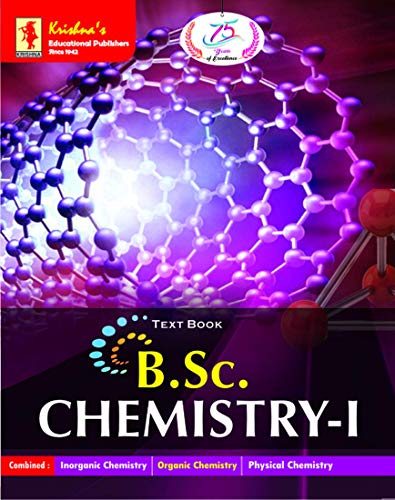
English | 2021 | ASIN: B0927LTTP6 | 1018 pages | PDF | 15 MB
SYLLABUS- B.Sc. CHEMISTRY-I, INORGANIC CHEMISTRY-I, UNIT-I
1.Atomic Structure: Idea of de-Broglie matter waves, Heisenberg uncertainty principle, atomic
2orbitals, Schrцdinger wave equation, significance of Y and Y, quantum numbers, radial and angular
wave functions and probability distribution curves, shapes of s, p, d, orbitals, Aufbau and Pauli
exclusion principles, Hund's multiplicity rule, Electronic configurations of the elements, effective
nuclear charge.
Periodic Properties: Atomic and ionic radii, ionization energy, electron affinity and 2.
electronegativity- definition, methods of determination or evaluation, trends in periodic table and
applications in predicting and explaining the chemical behaviour.
UNIT-II
3.Chemical Bonding: (A) Covalent Bond " Valence bond theory and its limitations, directional
characteristics of covalent bond, various types of hybridization and shapes of simple inorganic
+molecules and ions, valence shall electron pair repulsion (VSEPR) theory to NH3, H3O, SF4, CIF, ClF3 and H2O, M2O theory, homonuclear and heteronuclear (CO and NO) diatomic molecules,
multicenter bonding in electron deficient molecules, bond strength and bond energy, percentage ionic
character from dipole moment and electro-negativity difference. (B) Ionic Solids " Ionic structures,
radius ratio effect and coordination number, limitation of radius ratio rule, lattice defects,
semiconductors, lattice energy and Born-Haber cycle, salvation energy and solubility of ionic solids,
polarizing power and polarisability of ions, Fajan's rule, Metallic bond-free electron, valence bond and
band theories. (C) Weak Interactions " Hydrogen bonding, Van der Waals forces.
UNIT-III
4.s-Block Elements: Comparative study, diagonal relationship, salient features of hydrides, solvation
and complexation tendencies including their function in biosystems, an introduction to alkyls and
aryls.
5.Chemistry of Noble Gases: Chemical properties of the noble gases, chemistry of xenon, structure
and bonding in xenon compounds.
UNIT-IV
6.p-Block Elements: Comparative study (including diagonal relationship) of groups 13-17 elements,
compounds like hydrides, oxides, oxyacids and halides of group 13-16, hydrides of boron-diborane
and higher boranes, borazine, borohydrides, fullerenes, carbides, fluorocarbons, silicates (structural
principle), tetrasulphur tetra nitride, basic properties of halogens, interhalogens and polyhalides.
SYLLABUS- ORGANIC CHEMISTRY-I, UNIT-I
1. Structure and Bonding: Hybridization, bond lengths and bond angles, bond energy, localized and
delocalized chemical bonding, Van der Waals interactions, inclusion compounds, clatherates, charge
transfer complexes, resonances, hyperconjugation, aromaticity, inductive and field effects, hydrogen
bonding.
2. Mechanism of Organic Reactions: Curved arrow notation, drawing electron movements with allows,
half-headed and double-headed arrows, homolytic and heterolytic bond fission, Types of reagents "
electrophiles and nucleophiles, Types of organic reactions, Energy considerations. Reactive
intermediates " Carbocations, carbanions, free radicals, carbenes, arynes and nitrenes (with examples).
Assigning formal charges on intermediates and other ionic species. Methods of determination of
reaction mechanism (product analysis, intermediates, isotope effects, kinetic and stereochemical
studies).
3. Alkanes and Cycloalkanes: IUPAC nomenclature of branched and unbranched alkanes, the alkyl
group, classification of carbon atom in alkanes, Isomerism in alkanes, sources methods of formation
(with special reference to Wurtz reaction, Kolbe reaction, Corey-House reaction and decarboxylation of
download скачать
https://nitroflare.com/view/791C367DB02EE8E/jn20c.Krishnas..B.Sc..Chemistry.I.Combind.Edition5.pdf
https://rapidgator.net/file/426652cafbe932795badf6c7cc6cd70c/jn20c.Krishnas..B.Sc..Chemistry.I.Combind.Edition5.pdf

